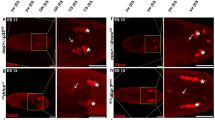Abstract
The Drosophila heart is composed of two cell types: cardioblasts (CB) and pericardial cells (PC). Whereas CBs act to maintain rhythmic contractions, the functions of accessory PCs are not clear. The close association between these two cell types has led to speculation of a cardio-regulatory role for PCs. However, we find that viability and cardiac function are normal in larvae following post-embryonic ablation of PCs by induced cell death. Removal of PCs during the larval instars or before metamorphosis results in viable and fertile adults. Interestingly, such animals have a reduced lifespan and increased sensitivity to toxic chemicals. Thus, although PCs may have an embryonic role in cardiogenesis, they do not appear to play a part later in cardiac function as suggested. However, the role of PCs in the uptake and sequestering of toxins, their sensitivity to toxic stress and the decreased lifespan of animals without PCs indicate the importance of PCs in organismal homeostasis.



Similar content being viewed by others
References
Alvarez AD, Shi W, Wilson BA, Skeath JB (2003) Pannier and pointedP2 act sequentially to regulate Drosophila heart development. Development 130:3015–3026
Bianchini A, Playle RC, Wood CM, Walsh PJ (2005) Mechanism of acute silver toxicity in marine invertebrates. Aquat Toxicol 72:67–82
Bier E, Bodmer R (2004) Drosophila, an emerging model for cardiac disease. Gene 342:1–11
Brand AH, Perrimon N (1993) Targeted gene expression as a means of altering cell fates and generating dominant phenotypes. Development 118:401–415
Brodu V, Mugat B, Roignant JY, Lepesant JA, Antoniewski C (1999) Dual requirement for the EcR/USP nuclear receptor and the dGATAb factor in an ecdysone response in Drosophila melanogaster. Mol Cell Biol 19:5732–5742
Bruckner K, Kockel L, Duchek P, Luque CM, Rorth P, Perrimon N (2004) The PDGF/VEGF receptor controls blood cell survival in Drosophila. Dev Cell 7:73–84
Chartier A, Zaffran S, Astier M, Semeriva M, Gratecos D (2002) Pericardin, a Drosophila type IV collagen-like protein is involved in the morphogenesis and maintenance of the heart epithelium during dorsal ectoderm closure. Development 129:3241–3253
Cripps RM, Olson EN (2002) Control of cardiac development by an evolutionarily conserved transcriptional network. Dev Biol 246:14–28
Crossley A (1985) Nephrocytes and pericardial cells. In: Kerkut GA, Gilbert LI (eds) Comprehensive insect physiology, biochemistry and pharmacology. Pergamon, Oxford, pp 487–515
Fujioka M, Wessells RJ, Han Z, Liu J, Fitzgerald K, Yusibova GL, Zamora M, Ruiz-Lozano P, Bodmer R, Jaynes JB (2005) Embryonic even skipped-dependent muscle and heart cell fates are required for normal adult activity, heart function, and lifespan. Circ Res 97:1108–1114
Holz A, Bossinger B, Strasser T, Janning W, Klapper R (2003) The two origins of hemocytes in Drosophila. Development 130:4955–4962
Johnson AN, Burnett LA, Sellin J, Paululat A, Newfeld SJ (2007) Defective decapentaplegic signaling results in heart overgrowth and reduced cardiac output in Drosophila. Genetics 176:1609–1624
Jung SH, Evans CJ, Uemura C, Banerjee U (2005) The Drosophila lymph gland as a developmental model of hematopoiesis. Development 132:2521–2533
Mandal L, Banerjee U, Hartenstein V (2004) Evidence for a fruit fly hemangioblast and similarities between lymph-gland hematopoiesis in fruit fly and mammal aorta-gonadal-mesonephros mesoderm. Nat Genet 36:1019–1023
McGuire SE, Le PT, Osborn AJ, Matsumoto K, Davis RL (2003) Spatiotemporal rescue of memory dysfunction in Drosophila. Science 302:1765–1768
Mills RP, King RC (1965) The pericardial cells of Drosophila melanogaster. Q J Microsc Sci 106:261–268
Molina MR, Cripps RM (2001) Ostia, the inflow tracts of the Drosophila heart, develop from a genetically distinct subset of cardial cells. Mech Dev 109:51–59
Monier B, Astier M, Semeriva M, Perrin L (2005) Steroid-dependent modification of Hox function drives myocyte reprogramming in the Drosophila heart. Development 132:5283–5293
Sellin J, Albrecht S, Kolsch V, Paululat A (2006) Dynamics of heart differentiation, visualized utilizing heart enhancer elements of the Drosophila melanogaster bHLH transcription factor Hand. Gene Expr Patterns 6:360–375
Ward EJ, Coulter DE (2000) Odd-skipped is expressed in multiple tissues during Drosophila embryogenesis. Mech Dev 96:233–236
Yi P, Han Z, Li X, Olson EN (2006) The mevalonate pathway controls heart formation in Drosophila by isoprenylation of Ggamma1. Science 313:1301–1303
Acknowledgements
We are grateful to Richard Cripps, Manfred Frasch, V. Sriram, Pernille Rorth, Helen Skaer and K. VijayRaghavan for antibodies, fly stocks and valuable comments, to B.S. Suma for help with confocal microscopy and to V. K. Sharma for advice on statistical analysis.
Author information
Authors and Affiliations
Corresponding author
Additional information
D.D. is supported by a CSIR-SPM fellowship. This work was funded by the JNCASR, the Council of Scientific and Industrial Research, and the Department of Biotechnology, Government of India.
Rights and permissions
About this article
Cite this article
Das, D., Aradhya, R., Ashoka, D. et al. Post-embryonic pericardial cells of Drosophila are required for overcoming toxic stress but not for cardiac function or adult development. Cell Tissue Res 331, 565–570 (2008). https://doi.org/10.1007/s00441-007-0518-z
Received:
Accepted:
Published:
Issue Date:
DOI: https://doi.org/10.1007/s00441-007-0518-z




